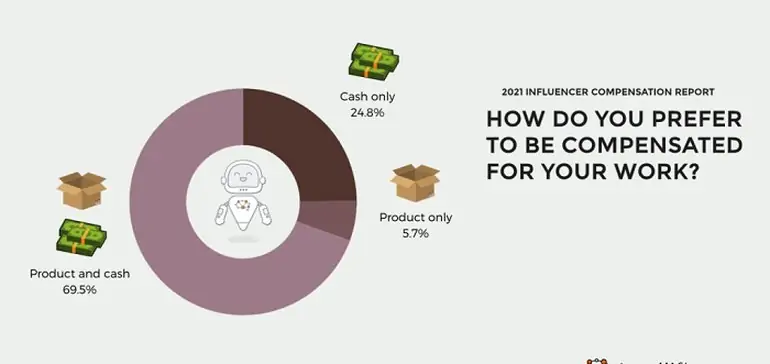Mobile App Development, SEO, Social Media, Uncategorized, Web Development, Website Design
New Report Looks at Influencer Payment Expectations Based on Audience Size and Platform
- By Brett Belau
04 Sep

What should you expect to pay an influencer for an Instagram or TikTok post promoting your product?
There can be significant variance in what each individual creator may charge, but to provide some more context for your planning, influencer connection platform Intellifluence recently conducted a survey of 1,249 influencers from the US, Canada and the UK, in order to glean more insight into their individual compensation expectations, which could help in your planning.
First off, the researchers asked survey participants what type of compensation they prefer – cash payment, cash and product or just products in return.
As you can see, ‘Product and Cash’ is clearly the top choice, so if you’re planning your influencer outreach, it’s likely worth honing in on this as your main offering – though again, individual expectations will vary.
In terms of costs per influencer post, Intellifluence has provided overviews based on audience size tiers across all the major platforms, starting with Instagram:

As per the graph, for smaller-scale influencers (up to 1,000 followers), you’re looking at around $193 per post, on average, while creators with more than 80k followers will generally charge more than $1, 000 per update.
It is also worth noting that audience size should not necessarily be your determining factor, because while larger audiences will drive broader reach and general brand awareness, various reports have also found that those with smaller, more niche followings can often drive better direct response, and better sales outcomes as a result.
There’s no perfect answer here, but if you can find a small influencer with a very active, very engaged following, that can be just as beneficial as someone with a much bigger audience in generating results for your brand – however an endorsement from a major celebrity will always drive greater brand awareness, and likely activity, so they also can’t be dismissed.
You’re just not very likely to get a Kyle Jenner to post about your product – if you can, definitely go for that. But if you can’t, taking a more measured, researched approach will likely deliver the best bang for your budget.
In this sense, these insights may provide some guidance as to how you can map out your spending, and measure your likely ROI, based on expected output.
On Facebook, the pricing per post is slightly lower, on average.

While Twitter is lower again – which makes sense, given the fast-moving nature of the tweet stream, which likely results in less exposure per tweet.

For YouTube and TikTok, Intellifluence has split its listings into ‘Peer/Authoritative’ influencers (regular creators who are not celebrities as such) and ‘Aspirational’ stars (higher profile/web celebrity creators).
And the pricing is significantly different between the two categories:

As you can see, the pricing, despite the category splits, is still largely defined by audience size, with the first category (Peer/Authoritative) covering creators with up to 20k followers, while the second segment covers those with 850k followers or more.
Which is a big jump, but as a comparative measure, these numbers give you some scope of what you can likely expect to be charged to reach these types of audiences on the platform.
The data for TikTok is actually pretty close to YouTube, and really, these two platforms are in their own sphere, separate from the other apps in many respects.

Of course, these insights are not definitive. 1,200 respondents is a good sample size, which should provide relevant scope for comparison, but there are many, many creators out there, and there’s no set structure, as such, as to what they charge and how much you’ll need to pay to get them to help share your brand messaging.
But it does provide some insight for your planning, and the numbers reflected here are similar to other influencer studies that have been conducted over the past year or so.
If you’re planning an influencer campaign, these estimates are around about what you should be budgeting for, and point to the level of response you likely need to see to offset your costs on the same.
Intellifluence has provided more specific insight in its full, 29-page report, which you can download here.
Source: www.socialmediatoday.com, originally published on 2021-09-03 00:02:00
Connect with B2 Web Studios
Get B2 news, tips and the latest trends on web, mobile and digital marketing
- Appleton/Green Bay (HQ): (920) 358-0305
- Las Vegas, NV (Satellite): (702) 659-7809
- Email Us: [email protected]

© Copyright 2002 – 2022 B2 Web Studios, a division of B2 Computing LLC. All rights reserved. All logos trademarks of their respective owners. Privacy Policy

![How to Successfully Use Social Media: A Small Business Guide for Beginners [Infographic]](https://b2webstudios.com/storage/2023/02/How-to-Successfully-Use-Social-Media-A-Small-Business-Guide-85x70.jpg)



![How to Successfully Use Social Media: A Small Business Guide for Beginners [Infographic]](https://b2webstudios.com/storage/2023/02/How-to-Successfully-Use-Social-Media-A-Small-Business-Guide-300x169.jpg)


Recent Comments